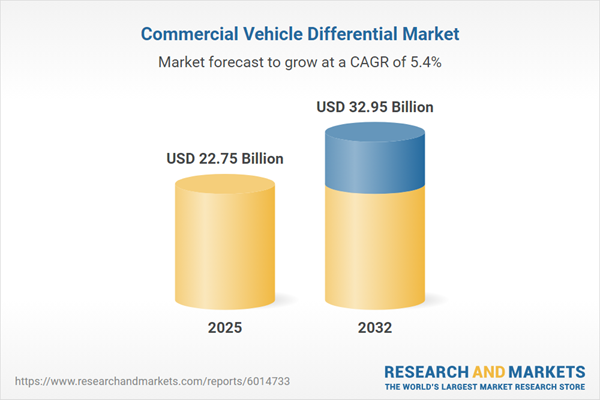Speak directly to the analyst to clarify any post sales queries you may have.
The commercial vehicle differential market is advancing rapidly, driven by technological innovation, regulatory mandates, and evolving fleet demands. This report delivers focused insights for senior decision-makers seeking to assess risk, identify high-value growth segments, and build resilient strategies in a changing industry.
Market Snapshot: Commercial Vehicle Differential Market
The commercial vehicle differential market grew from USD 21.56 billion in 2024 to USD 22.75 billion in 2025, and is projected to reach USD 32.95 billion by 2032 at a CAGR of 5.44%. This trajectory is shaped by heightened demand for advanced drivetrain solutions serving an expanding global logistics and transportation sector, alongside increasing integration of electronic systems and lightweight materials. The competitive environment is intensifying as new suppliers and established players address these priorities.
Scope & Segmentation
- Vehicle Types: Heavy commercial vehicles, medium commercial vehicles, light commercial vehicles
- Differential Types: Limited slip (clutch and helical), locking (automatic, manual), open, torque vectoring (electronic, hydraulic)
- End User Industries: Agriculture (crop farming, livestock farming), construction (building, civil, road), mining (surface, underground), transportation and logistics (cold chain, freight, inter/intra-city transit)
- Drive Types: All-wheel drive, front-wheel drive, rear-wheel drive
- Material Types: Alloy steel, aluminum, cast iron
- Replacement Types: Aftermarket, original equipment
- Sales Channels: Aftermarket, OEM
- Regions: Americas (including North America and Latin America), Europe, Middle East & Africa, Asia-Pacific
- Covered Companies: ZF Friedrichshafen AG, Dana Incorporated, American Axle & Manufacturing Inc., Meritor Inc., Eaton Corporation PLC, GKN Automotive Limited, BorgWarner Inc., JTEKT Corporation, The Timken Company, Neapco Holdings LLC
Key Takeaways: Strategic Insights
- Electrification and digital control systems are rapidly transforming drivetrain solutions, pushing suppliers to develop modular and software-driven differentials.
- Fleet operators in core markets are prioritizing predictive maintenance and reliability, leading to strong demand for sensor-enabled, real-time monitoring components.
- Regional adoption patterns vary; North America emphasizes remanufacturing and cost optimization, Europe focuses on emissions and lightweighting, while Asia-Pacific is expanding in mining and agricultural segments.
- Technological shifts such as additive manufacturing are reducing prototype lead times and facilitating the design of structurally efficient, lightweight differential housings.
- Segment-specific requirements are pronounced: heavy vehicles need maximum torque capacity, while light vehicles stress compactness and efficiency for urban logistics.
- Strategic collaborations, targeted M&A, and digital simulation tools are enabling leading firms to accelerate product development and reduce operational risks.
Tariff Impact: Navigating Regulatory and Cost Challenges
U.S. tariff policies on imported differential components and raw materials have increased cost pressures and disrupted traditional supply chains. Manufacturers are responding through nearshoring, diversified sourcing, and long-term price agreements to sustain margin discipline and supply continuity. Tariff fluctuations highlight the importance of flexible procurement, trade compliance, and strategic contract management across the value chain.
Methodology & Data Sources
This commercial vehicle differential market analysis leverages a multi-stage approach combining in-depth secondary research, qualitative expert interviews, and structured quantitative surveys with OEMs, tier-one suppliers, and aftermarket firms. Rigorous triangulation, segmentation analysis, and statistical validation ensure high credibility and actionable depth.
Why This Report Matters
- Provides scenario planning support for risk management across global supply chains and evolving tariff environments.
- Delivers actionable insights into emerging technologies, performance drivers, and segment-level requirements supporting competitive differentiation.
- Enables senior decision-makers to identify and prioritize resilient sourcing strategies, partnership opportunities, and high-growth segments across multiple geographies.
Conclusion
The commercial vehicle differential market is at a critical inflection, combining digital transformation, supply chain complexity, and sustainability imperatives. Stakeholders equipped with timely, in-depth market analytics are best positioned to adapt strategies, ensure operational resilience, and unlock future growth opportunities in drivetrain innovation.
Additional Product Information:
- Purchase of this report includes 1 year online access with quarterly updates.
- This report can be updated on request. Please contact our Customer Experience team using the Ask a Question widget on our website.
Table of Contents
3. Executive Summary
4. Market Overview
7. Cumulative Impact of Artificial Intelligence 2025
Companies Mentioned
The companies profiled in this Commercial Vehicle Differential market report include:- ZF Friedrichshafen AG
- Dana Incorporated
- American Axle & Manufacturing, Inc.
- Meritor, Inc.
- Eaton Corporation PLC
- GKN Automotive Limited
- BorgWarner Inc.
- JTEKT Corporation
- The Timken Company
- Neapco Holdings LLC
Table Information
| Report Attribute | Details |
|---|---|
| No. of Pages | 197 |
| Published | October 2025 |
| Forecast Period | 2025 - 2032 |
| Estimated Market Value ( USD | $ 22.75 Billion |
| Forecasted Market Value ( USD | $ 32.95 Billion |
| Compound Annual Growth Rate | 5.4% |
| Regions Covered | Global |
| No. of Companies Mentioned | 11 |









